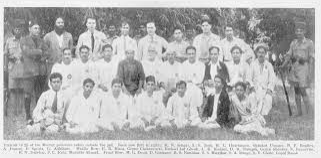What is Meerut Conspiracy Case
Seeing the growing influence of the Communists among the workers, peasants, students and other working classes, there was panic among the British rulers and the Indian bourgeoisie. This increasing influence was not only a threat to the British rulers, but it was also a danger bell for the mill owners of India.
 |
| IMAGE CREDIT-WIKIPEDIA |
From April 1928, the mill owners of India put pressure on the government to take strict action against the communists. The governments of Bengal and Bombay also requested the central government to take action to check the influence of the communists. To ban their activities, the government issued the Ordinance of Public Safety in 1928 and it was used against the communists. In addition (20 March 1929) the government arrested 31 communist and trade union leaders from across the country and they were taken to Meerut to try those conspiracies.
Meerut Conspiracy Case 1928
In fact, the plan to prosecute the communists was made in 1928 itself. On September 13, 1928, a telegram was sent to the Viceroy’s secretary, in which he wrote—
“We are looking into the possibility of conducting extensive conspiracy trials against important leaders of this time. The British authorities chose Meerut for this trial because Bombay and Calcutta were communist strongholds. Prosecution there would help the British rulers maintain law and order. There was a fear of breaking up.
The Secretary of the Home Department of India wrote a letter
“Given the dangerous environment found in Bombay and Calcutta today, it is not appropriate to prosecute communists there.”
Why was Meerut chosen to prosecute?
Meerut was also chosen for trial because there was no rule to consider the case by sight. The government feared that the people would not sit still even on the arrests of the communists. The government was afraid of a mass movement.
Lord Irwin, in a letter to the Governors of Bengal and Bombay on January 18, 1929, directed that a large number of police forces were required to be present at those places at the time of the arrest of the Communists. Not only this, Bombay was so afraid of the possible disturbance of the workers by the arrest of the Communists that it sought the help of the army for that time and the army units were deployed in Bombay from 6 am that day.
After arresting these communists, the government filed a case against them in Meerut. The trial lasted three and a half years. 300 witnesses were examined. Around 3000 martyrs were produced in the court and a total of Rs 150000 was spent on the trial. During the trial, the communists declared that they were revolutionary and wanted to end British imperialism in India.
 |
| IMAGE CREDIT-www.wcml.org.uk |
READ ALSO
Non-cooperation Movement, Causes, Consequences, Chauri-Chaura Incident
During the trial, Muzaffar Ahmed said emphatically—-
“I am a revolutionary communist. Our party adheres to the program, principles and policies of the Communist International and, as far as circumstances permit, gives their full publicity.”
Shripad Dange said, “The first aim of the communists is to overthrow imperialism from India.”
Ghate declared, “The communists want to dismantle the existing state machinery and install a new machinery in its place until communism comes.”
Joglekar said, “As a communist, I believe in Marxism-Leninism.”
Mirajkar said, “I say this openly that I want to destroy the sovereignty of capital.”
Sohan Singh Josh declared, “We want to end the empire along with imperialism.”
Abdul Majeed said, “I have full faith that one day the proletarian revolution will be successful in India, we communists are trying to bring about this revolution.”
READ ALSO
India Council Act 1909 -| Birth of communal division in India | 1909 Marle-Minto Act
Lala Hardayal and Ghadar Party | Ghadar Movement
Congress reaction on Meerut case
At the time when these people were fearlessly giving statements in the court, then Jawaharlal Nehru came with a proposal for them from the Congress side. Through this proposal, the Congress leaders sent the communists saying that the Congress would not be able to pay attention to their cases due to the future civil disobedience movement. So these people should confess their crime before the court.
READ ALSO
Meerut trial results
The verdict of the Meerut case was pronounced on 16 January 1933. 27 accused were given harsh punishment. It was decided to give the harshest punishment to Muzaffar Ahmed. He was sentenced to life in black water.
The organization of the party became very weak due to the imprisonment of the Communist leaders. The labor-peasant parties split. But this trial could not get the communists out of India. Revolutionary sentiments emerged among the people of India from the statements of the trial accused and their respect for them increased in their hearts. The government campaigned loudly for this case to create fear in the hearts of the people but it had the opposite effect. This propaganda took the ideas of the communist leaders to the people.
In the words of Muzaffar Ahmed, “The Meerut Conspiracy Trial strengthened the roots of communism in India.” In fact, the trial “provided far-reaching benefits to the cause of the communists.” Provided a strong foundation for communism.
When the main leaders of the party were jailed, the responsibility of leadership of the party fell on the shoulders of the young members of the party, Abdul Majeed BT Ranadive, Mrs Nambiar, Somnath Lahiri and RD Bharadwaj. He tried to reorganize the party. The jailed leaders supported him in this effort. He kept in touch with the party and continued to provide direction to the movement. He also secretly sent many documents out of prison and appealed to the Communist International to save the party.
YOU MAY READ ASLO
guru purnima history and lagacy